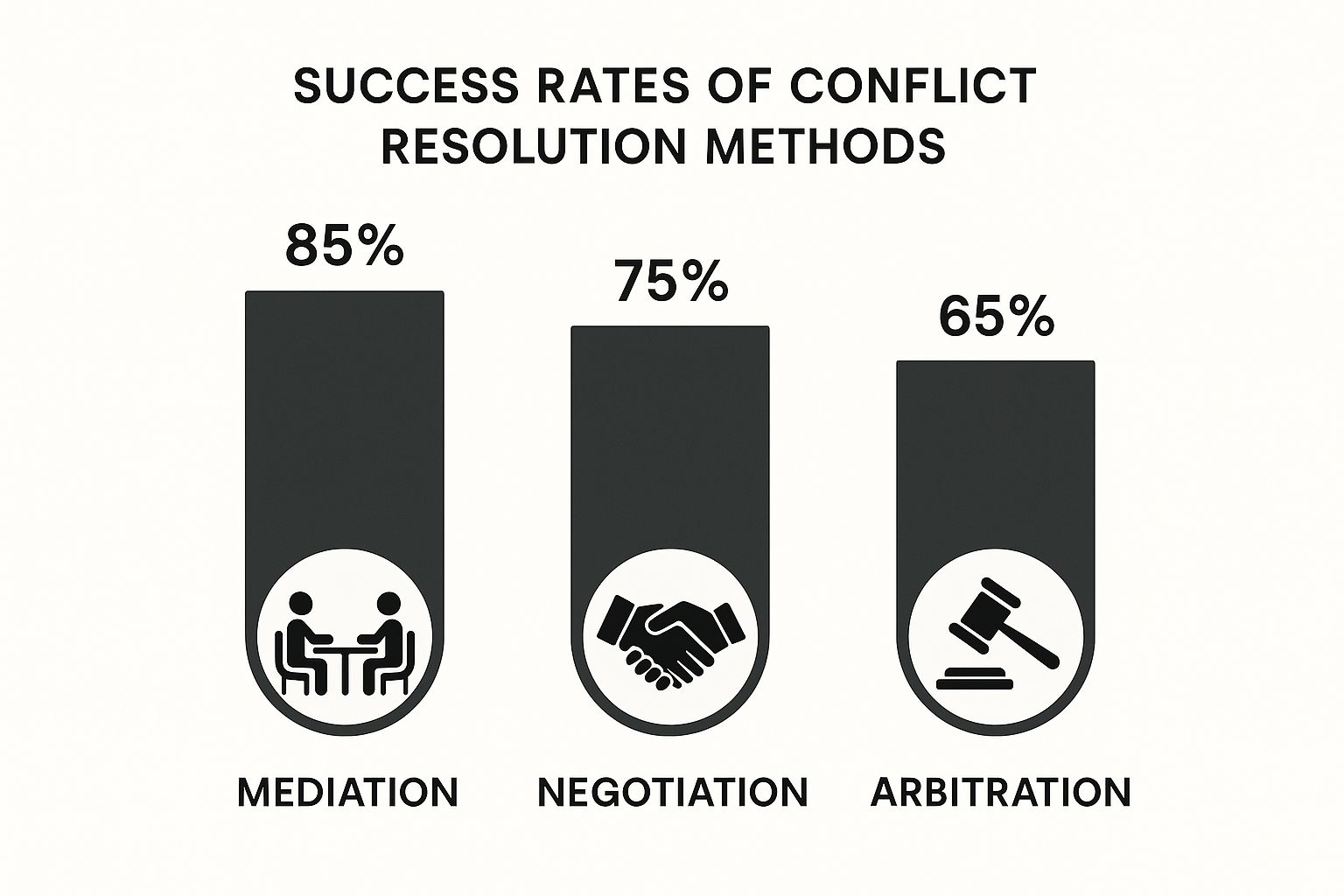The Hidden Cost of Workplace Conflict: More Than Just Dollars

When we think of workplace conflict, we often picture shouting matches and uncomfortable meetings. But the real cost goes much deeper than these obvious disruptions. Conflict significantly impacts productivity, innovation, and the overall health of an organization. Unresolved issues quietly drain resources and affect the bottom line.
The Productivity Drain
One immediate consequence of workplace conflict is reduced productivity. When team members are caught up in interpersonal problems, their focus drifts from their work. This lack of concentration leads to missed deadlines, mistakes, and lower quality work. Time spent gossiping, complaining, or avoiding colleagues involved in disputes further chips away at productive work hours. This creates a sense of inefficiency and hurts team morale. Across the globe, and especially in the U.S., employees spend a significant amount of time dealing with conflict. In fact, employees spend roughly 2.8 hours per week navigating workplace conflict, which translates to an estimated $359 billion in paid hours annually in the U.S. alone. Find more detailed statistics here.
Stifled Innovation and Creativity
A harmonious workplace nurtures creativity and innovation. But when conflict arises, this collaborative and open environment is disrupted. Employees hesitate to share ideas or challenge the status quo, fearing backlash or further conflict. This reluctance can stifle innovation and prevent new ideas from taking root, ultimately hindering the organization's ability to grow and thrive. Unresolved conflict also leads to lower employee engagement, impacting their willingness to contribute creatively.
The High Cost of Turnover
The impact of workplace conflict reaches beyond productivity and innovation, affecting employee retention. A toxic work environment filled with unresolved conflict increases stress, job dissatisfaction, and burnout. This creates a cycle of negativity, impacting employee well-being. Talented employees will look for better opportunities elsewhere, resulting in high turnover and the loss of valuable institutional knowledge. The cost of recruiting, hiring, and training replacements is substantial, placing a further strain on resources. Addressing conflict effectively isn't just about keeping the peace; it's a vital strategy for retaining valuable talent and minimizing recruitment expenses.
Decoding the DNA of Workplace Disputes
Navigating disagreements effectively is essential for a thriving work environment. Truly successful conflict resolution hinges on understanding the root causes of tension. While some disagreements may seem personal, they often originate from deeper structural issues within the organization. This means we need to look beyond the surface and explore the underlying factors that contribute to these disputes. By understanding these root causes, we can create more effective and lasting solutions.
Structural Issues: The Hidden Culprits
One of the most common sources of conflict is resource competition. When teams or individuals feel they lack the necessary resources—whether it's budget, equipment, or personnel—tensions can escalate quickly. Imagine two departments competing for a limited budget; clashes over priorities and funding are almost inevitable. If this competition isn't managed effectively, it can create a hostile atmosphere and hinder collaboration.
Another culprit is unclear expectations. When roles and responsibilities are ambiguous, individuals may inadvertently overstep boundaries, leading to frustration and resentment. This is particularly common during periods of organizational change or when new projects are launched without clear guidelines.
Finally, communication barriers significantly contribute to workplace disputes. Poor communication—whether due to ineffective channels, lack of transparency, or simple misunderstandings—can easily escalate minor disagreements. This challenge is amplified in today's hybrid and remote work environments, where communication is often asynchronous and lacks the nuances of face-to-face interaction. These barriers prevent timely resolution, allowing small issues to fester and grow into larger problems.
Recognizing the Warning Signs
Identifying the early warning signs is paramount for effective conflict resolution. These signals often precede more disruptive situations. One common sign is a shift in communication patterns. Teams or individuals who previously collaborated well might start avoiding each other or communicating in a curt or passive-aggressive way.
Another red flag is an increase in gossip or negativity. Underlying conflict often manifests as whispers and complaints within the team. This negativity can quickly create a toxic environment, highlighting the importance of recognizing these patterns early on.
To better understand these warning signs in the context of common conflict sources, let's examine the following table:
Common Sources of Workplace Conflict
This table categorizes and describes the major triggers of conflict in professional environments.
| Conflict Source | Description | Warning Signs | Prevention Strategies |
|---|---|---|---|
| Resource Competition | Teams or individuals feel they lack necessary resources (budget, equipment, personnel). | Increased competition for projects/assignments, complaints about resource allocation, hostility between teams. | Transparent resource allocation process, clear prioritization of projects, open communication about resource limitations. |
| Unclear Expectations | Ambiguity around roles and responsibilities. | Individuals stepping on each other's toes, duplicated work, confusion about project ownership. | Clearly defined roles and responsibilities, documented processes and workflows, regular check-ins and feedback sessions. |
| Communication Barriers | Ineffective communication channels, lack of transparency, or misinterpretations. | Increased miscommunication, missed deadlines, avoidance of interaction, passive-aggressive communication. | Establish clear communication protocols, utilize multiple communication channels (email, instant messaging, video conferencing), promote active listening and feedback. |
This table provides a framework for understanding the connection between the source of conflict and the resulting behaviors. By recognizing these warning signs and implementing the preventative strategies, we can proactively address conflict before it escalates.
Personality and Work Styles: A Double-Edged Sword
While personality differences can fuel innovation and creativity, they can also become a source of friction. Diverse work styles, while beneficial for problem-solving, can lead to misunderstandings and clashes if not managed carefully. For instance, a detail-oriented individual might clash with a colleague who prefers a broader perspective.
However, understanding and valuing these differences is crucial for transforming potential conflict into productive collaboration. By viewing conflict through behavioral, cultural, and organizational lenses, we develop the diagnostic skills to address the root causes. This approach facilitates more sustainable resolutions and fosters stronger team dynamics. We move beyond simply treating the symptoms and instead address the underlying issues—the very DNA of the disputes themselves.
Why Leaders Fail at Conflict Resolution (And How to Change That)

Even the most experienced leaders sometimes hesitate to address team conflicts. Often, they allow tensions to escalate before stepping in. This avoidance can come from several sources. Perhaps they lack confidence in their conflict resolution abilities. Maybe they're afraid of making things worse. Or, they might simply be prioritizing other urgent tasks.
But avoiding conflict has real consequences. Manageable disagreements can become significant disruptions. While addressing conflict directly might be uncomfortable, it's essential for a productive and positive team environment.
The Fear Factor: Why Leaders Avoid Conflict
One key reason leaders avoid conflict is the fear of fallout. They worry about damaging relationships with team members. They might be concerned about creating a hostile atmosphere, or appearing incompetent. Some leaders also lack the training and skills to effectively navigate complex interpersonal issues.
This lack of preparation makes them feel unequipped to deal with emotionally charged situations. For example, a leader might avoid a conflict between two team members because they don't know how to mediate the discussion fairly and constructively. This avoidance, ironically, worsens the problem. Resentment festers and team performance suffers.
Globally, almost 49% of emerging leaders struggle with effective conflict management. This underscores the need for better training and development in this critical area. The lack of formal training in conflict management further fuels workplace tensions. Discover more insights about conflict management research here.
The Impact of Leadership Styles
Different leadership styles can either escalate or mitigate conflict. An authoritarian leader, for example, might suppress disagreement. This leads to unresolved resentment simmering under the surface. On the other hand, a laissez-faire leader might not intervene at all, allowing conflicts to grow unchecked.
A leader who fosters psychological safety empowers team members to express their concerns openly and respectfully. This allows for early intervention and prevents minor disagreements from becoming major conflicts. Leaders who prioritize open communication and create a safe environment for dialogue transform conflict resolution from a dreaded task into a chance for growth and team unity.
Creating a Culture of Constructive Conflict
Successfully handling conflict requires more than just resolving individual disputes. It requires building a conflict-resilient team culture. This means establishing clear communication norms, promoting active listening, and creating regular feedback opportunities.
For instance, regular team meetings where individuals can openly discuss challenges and concerns can prevent misunderstandings from escalating. Leaders can also encourage feedback by creating a culture where it's seen as a helpful tool for improvement rather than a personal attack.
By fostering a culture that values open communication and constructive feedback, leaders equip their teams with the tools to manage conflict effectively and proactively. This not only reduces disruptions, but also fosters a more positive and productive work environment.
Battle-Tested Conflict Resolution Techniques That Actually Work

Effective conflict resolution is the cornerstone of any thriving workplace. Moving beyond generic advice, let's explore proven approaches you can implement immediately. Remember, it's not about a one-size-fits-all solution. True success lies in understanding the nuances of each situation and applying the right technique. Leaders often benefit from specialized training in this area. Explore the advantages of focused leadership training for managers.
Understanding the Five Core Approaches
Five key conflict resolution strategies exist, each tailored to specific circumstances and relationship dynamics. Adapted from the Thomas-Kilmann Conflict Mode Instrument (TKI), these strategies provide a powerful framework for navigating disagreements effectively.
-
Avoiding: This involves strategically stepping back from the conflict, allowing time for it to resolve itself or decrease in importance. This can be helpful for minor disagreements or when the potential disruption of confrontation outweighs the benefits of immediate resolution. However, be mindful that frequent avoidance can lead to unresolved resentment.
-
Accommodating: Prioritizing the other party's needs over your own is at the heart of accommodation. This strategy excels in preserving valuable relationships when the issue is of greater importance to the other person. However, consistently placing others' needs above your own can lead to your own needs being overlooked.
-
Competing: This assertive approach prioritizes achieving your desired outcome, sometimes at the expense of the other party. Competing can be necessary when decisive action is required or when protecting your interests is paramount. However, overuse can damage relationships if not applied carefully.
-
Compromising: This strategy encourages finding a middle ground. Both parties make concessions to reach a mutually acceptable, if not ideal, solution. Compromise can be extremely valuable when a rapid resolution is critical or when full collaboration proves challenging. Be aware, however, that compromise may not fully address the underlying causes of the conflict.
-
Collaborating: This approach strives for a true win-win outcome. It involves open communication, active listening, and a shared commitment to finding a solution that fully satisfies everyone involved. While ideal for complex issues, collaboration can require more time and effort.
Choosing the Right Technique: A Data-Driven Approach
The best strategy depends on a multitude of factors: the conflict's severity, the relationship's importance, and the desired outcome. The following data chart illustrates the effectiveness of each approach based on these factors.
Conflict Resolution Effectiveness
(This data chart visualizes the relative effectiveness of various conflict resolution strategies in different situations.)
| Conflict Factor | Avoiding | Accommodating | Competing | Compromising | Collaborating |
|---|---|---|---|---|---|
| Minor Disagreement | High | Medium | Low | Medium | Medium |
| Important Relationship | Low | High | Low | Medium | High |
| Quick Resolution Needed | Medium | Medium | High | High | Low |
| Complex Issue | Low | Low | Low | Medium | High |
As the chart shows, collaboration excels in addressing complex issues and nurturing valuable relationships. On the other hand, competing can be more effective when a quick resolution is paramount, though it may impact relationships. Avoiding is best suited for minor issues but less so for crucial relationships or intricate situations. The chart reinforces the importance of considering context when selecting a resolution strategy.
Implementing Conflict Resolution Techniques
Implementing these techniques effectively requires thoughtful preparation and skillful execution. Active listening, clear communication, and the ability to reframe accusations into shared challenges are essential for success. For instance, instead of saying, "You always interrupt me in meetings," try, "I've noticed I haven't been able to fully share my thoughts in meetings recently. Could we explore ways to ensure everyone has ample opportunity to speak?" This shift in language promotes collaboration and focuses on solutions rather than blame.
Engineering a Conflict-Resilient Team Culture

Resolving individual conflicts is just one piece of the puzzle. The larger, more impactful challenge lies in fostering a conflict-resilient team culture. This means creating an environment where productive disagreement is encouraged, and destructive conflict is minimized. It's a proactive approach to shaping team dynamics and communication, leading to greater innovation and stronger team cohesion.
Establishing Communication Norms and Feedback Mechanisms
High-performing organizations understand that clear communication is key to conflict prevention. They establish communication norms that encourage respectful dialogue and constructive feedback. For example, regular team meetings create a safe space for open discussion, preventing misunderstandings from escalating. This transparency reduces misinterpretations and assumptions that can fuel conflict.
Robust feedback mechanisms are also essential. Regular feedback, both formal and informal, should be the norm. This could involve formal performance review systems or simply fostering a culture where feedback is a tool for growth, not criticism.
Practical Frameworks for Conflict Resolution
Specific protocols for handling conflict are the backbone of a conflict-resilient team. Team conflict resolution workshops are a great starting point. These workshops equip team members with practical skills to address disagreements constructively, covering conflict resolution styles, communication techniques, and de-escalation strategies. This creates a shared understanding of how to navigate conflict.
Teams also benefit from establishing their own conflict resolution protocols. This might include a designated mediator, a step-by-step process for addressing disagreements, or a clear escalation path for unresolved issues. These protocols enable faster, more effective conflict resolution.
The Power of Retrospectives
Regular retrospectives are invaluable for uncovering systemic conflict triggers. These meetings provide a dedicated time for teams to reflect on their work processes, communication patterns, and team dynamics. By analyzing past conflicts, teams can identify recurring issues and patterns, and then develop strategies for preventing similar disagreements. Perhaps a retrospective reveals that unclear project assignments are a frequent source of conflict, leading the team to implement clearer task allocation procedures.
This ongoing reflection and adjustment is key to a truly conflict-resilient culture. Teams continuously learn from experience and proactively address the root causes of conflict, creating a healthier, more productive work environment.
Recognizing and Rewarding Constructive Conflict
Building a conflict-resilient culture also means recognizing and rewarding constructive conflict behaviors. This reinforces positive actions and encourages healthy disagreement. Acknowledging individuals who effectively mediate conflicts or demonstrate active listening skills can inspire others.
Integrating conflict resolution skills into team development initiatives further strengthens this positive reinforcement. By making conflict resolution a core competency, organizations show their commitment to a positive and productive work environment. This shifts teams from conflict avoidance to leveraging diverse perspectives for innovation and success.
Navigating Conflict Across Cultural and Personality Divides
Today's workplace thrives on a rich tapestry of cultures, personalities, and individual work styles. This diversity, while a source of strength and innovation, presents unique opportunities for growth in how we approach conflict resolution. Truly effective conflict resolution requires not just understanding the core techniques, but adapting them with cultural intelligence. It's about moving beyond standardized solutions and embracing the uniqueness of each individual and their background.
Understanding Cultural Influences on Conflict
Our cultural backgrounds profoundly shape how we perceive and respond to conflict. Some cultures value direct communication and confrontation, while others may prefer more nuanced, indirect approaches, or mediation. For example, raising your voice might be perfectly acceptable in one culture, yet seen as disrespectful in another. When building a resilient team, recognizing these cultural differences is paramount. These nuances can easily become points of conflict if not understood and addressed proactively. Overcoming cross-cultural communication challenges strengthens empathy and understanding across teams.
Cultural nuances extend beyond the spoken word. Body language, nonverbal cues, and even the comfortable distance between individuals during conversations (personal space) can vary significantly between cultures. Misinterpretations can escalate disagreements, so developing cultural sensitivity is key. This means actively learning about different cultural norms, acknowledging our own biases, and adapting our communication style accordingly.
Addressing Generational and Personality Differences
Generational differences also add a unique dimension to conflict resolution. Each generation often holds different expectations around communication styles, workplace hierarchy, and giving and receiving feedback. Younger generations may lean towards more informal and direct communication, while others may appreciate a more formal approach.
Individual personality differences further influence how people react to conflict. Some are naturally assertive, while others prefer a more conciliatory style. Understanding these personality traits helps tailor communication and conflict resolution strategies for maximum effectiveness.
Accommodating Neurodiversity in Conflict Resolution
Neurodiversity enriches the workplace, but also calls for thoughtful approaches to conflict resolution. Individuals with neurodivergent conditions, like autism or ADHD, may process information and communicate differently. This can sometimes lead to misunderstandings. Creating an inclusive environment is essential. This means ensuring everyone feels comfortable expressing themselves, and adapting communication to individual needs. This could involve providing clear instructions, offering various communication channels, and allowing for breaks during discussions.
Building a Culturally Intelligent Organization
Truly successful organizations move beyond simply addressing individual conflicts; they proactively create systems that embrace diverse conflict management styles. This includes establishing clear guidelines for respectful communication, offering training on cultural awareness and conflict resolution, and implementing flexible resolution processes that cater to different personalities and cultural backgrounds.
These organizations prioritize mutual respect and understanding. They foster a culture where diversity is celebrated, and individuals feel empowered to express themselves openly and honestly. This not only mitigates conflict, but also fosters collaboration, innovation, and a strong sense of belonging.
Are you ready to empower your HR team with the skills to navigate these complex challenges? The Global Human Resource Institute offers comprehensive training and certification programs to equip HR professionals with the knowledge and tools they need to cultivate a positive and productive work environment. Visit Global Human Resource Institute to learn more and transform your workplace culture.




0 Comments